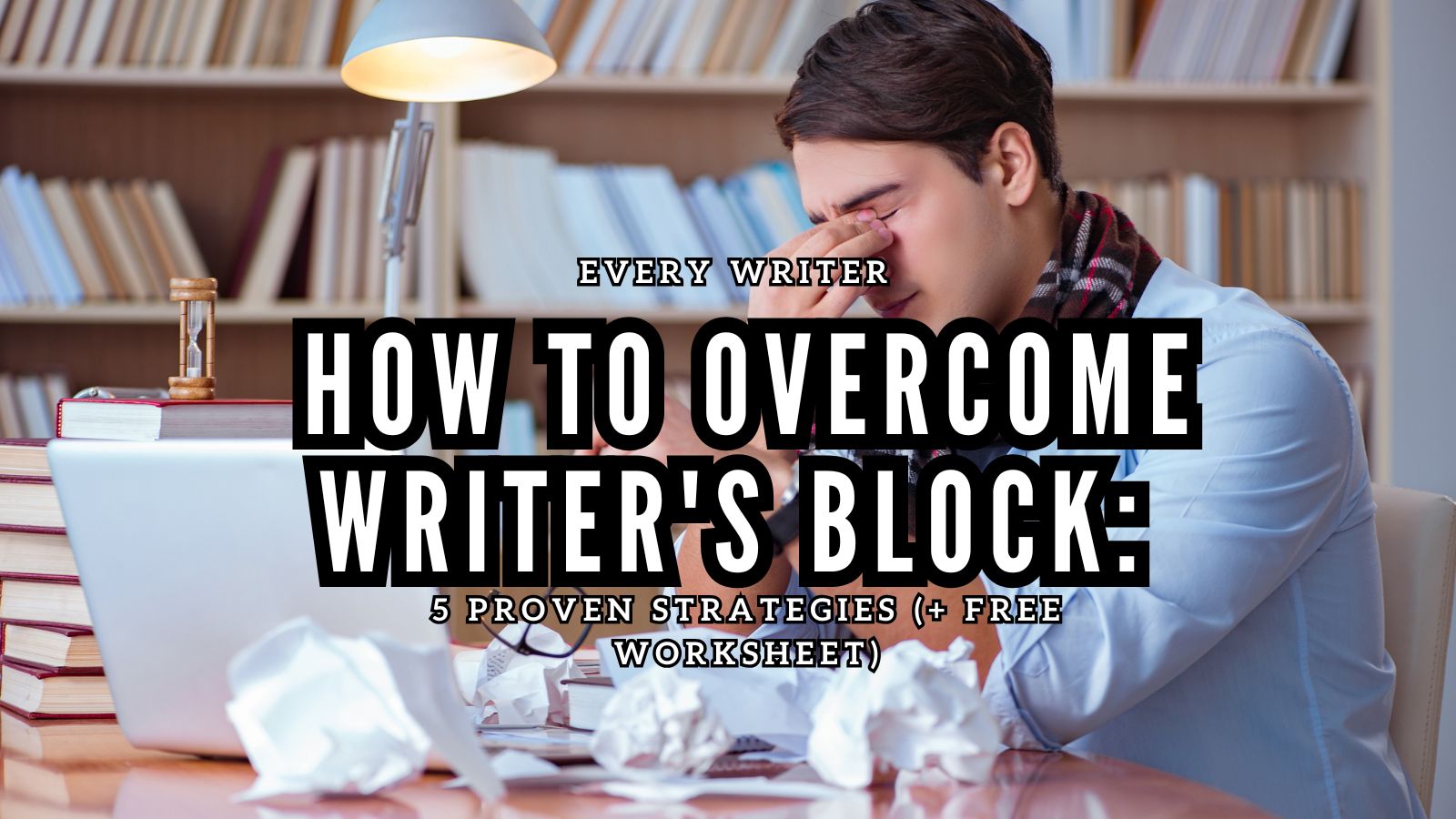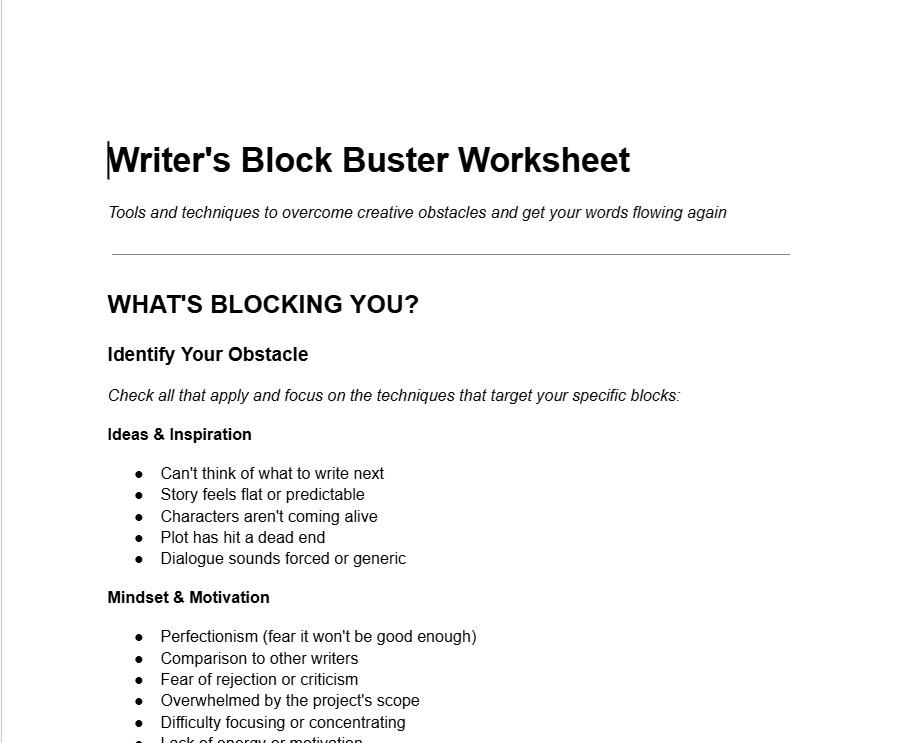How to Overcome Writer’s Block: 5 Proven Strategies (+ Free Worksheet)
Staring at a blank page, cursor blinking accusingly as minutes tick by without a single word appearing? You’re not alone. Writer’s block is disdained by younger members but seems to gain respect at higher levels where it occurs more commonly. It can range from temporary frustration to long-term creative paralysis, affecting everyone from bestselling novelists to scholars and students. But here’s the encouraging truth: writer’s block is a challenge, not a permanent creative sentence.
In this guide, we’ll explore the science behind writer’s block, identify the different types you might experience, share five proven strategies to break through creative barriers, and provide you with our free Writer’s Block Buster Worksheet to transform frustration into creative flow.
What Exactly Is Writer’s Block?
Writer’s block is more than just procrastination—it’s a psychological barrier that prevents you from producing new work or makes the writing process unusually difficult. Neurologically, it often involves heightened activity in your brain’s amygdala (the fear center) and reduced activity in the regions responsible for creativity and flow.
This creative barrier typically manifests in several distinct forms:
Common Types of Writer’s Block
- The Perfectionist Block – When impossibly high standards prevent you from writing anything at all
- The Empty Well Block – When you’ve simply run out of ideas or inspiration
- The Fear-Based Block – When anxiety about criticism or failure paralyzes your creativity
- The Burnout Block – When mental exhaustion leaves you unable to generate new content
- The Distraction Block – When focus issues repeatedly interrupt your creative process
Each type requires a slightly different approach to overcome, which is why identifying your specific block is the crucial first step.
What Causes Writer’s Block?
Understanding the underlying causes of your creative barrier can help you address it more effectively:
- Perfectionism – The relentless pursuit of flawless first drafts often results in writing nothing at all. Perfectionism creates unrealistic expectations that make the act of writing feel impossibly daunting.
- Self-Doubt – That inner critic whispering “not good enough” can freeze your creativity mid-sentence. Research from the Journal of Creative Behavior suggests that negative self-talk directly impacts creative performance by activating stress responses in the brain.
- Burnout – Mental exhaustion from writing too much or from other life stressors can deplete your creative resources. Your brain needs recovery time to maintain creative function.
- Lack of Inspiration – Sometimes the well runs dry, and you simply don’t know what to write about. This often happens when writers become disconnected from their curiosity or passion.
- Distractions – The average person checks their phone 96 times a day—that’s once every 10 minutes. With social media, emails, and life responsibilities competing for attention, maintaining creative focus becomes increasingly challenging.
- Unclear Direction – Without a clear outline or plan, it’s easy to get lost in the writing process and become overwhelmed by possibilities.
Recognizing which factors are blocking your writing is the first step toward developing targeted solutions.
5 Proven Strategies to Break Through Writer’s Block
1. Practice Freewriting
What it is: Freewriting involves setting a timer (usually 10-15 minutes) and writing continuously without stopping, editing, or judging what appears on the page.
Why it works: This technique bypasses your inner critic by creating a judgment-free zone. Neuroscience research shows that freewriting activates the brain’s default mode network—the same network that lights up during creative thinking.
How to do it effectively:
- Set a timer for 10 minutes
- Write continuously without stopping
- Don’t edit, correct, or judge what appears
- If you get stuck, write “I’m stuck” until new ideas emerge
- Optional: Use a prompt like “The most interesting thing about my character/topic is…” to get started
Author Maya Angelou used a variation of freewriting every morning, committing to filling a certain number of pages regardless of quality, which helped her overcome creative resistance throughout her career.
2. Change Your Writing Environment
What it is: Physically relocating your writing space or altering your surroundings to create a fresh perspective.
Why it works: Environmental psychology studies show that changing your physical surroundings can trigger new neural pathways and associations, potentially unlocking creativity that was blocked in your regular environment.
How to do it effectively:
- Try writing in a coffee shop, library, or park
- Switch from digital to analog (or vice versa)
- Rearrange your desk or writing space
- Change the lighting, add plants, or introduce soft background noise
- Write at a different time of day than usual
J.K. Rowling famously wrote parts of Harry Potter in cafés, finding the ambient noise and change of scenery conducive to creativity when she felt stuck at home.
3. Use Writing Prompts
What it is: Predetermined topics, phrases, or scenarios that provide a starting point for your writing.
Why it works: Prompts give your brain a specific direction, eliminating the paradox of choice that can cause creative paralysis. They also provide external structure when internal motivation is lacking.
How to do it effectively:
- Choose prompts related to your project when possible
- Set a 15-minute timer and write without stopping
- Try perspective shifts (write from an antagonist’s viewpoint)
- Use visual prompts (photos or artwork) for sensory inspiration
- Experiment with constraints (write a scene using only dialogue)
Our Writer’s Block Buster Worksheet includes 10 versatile prompts designed to kickstart your creativity regardless of your genre or project type.
4. Take a Strategic Break
What it is: Intentionally stepping away from writing to engage in activities that rejuvenate creative thinking.
Why it works: Research in cognitive psychology shows that problem-solving abilities improve after periods of mental rest. Your brain continues working on creative challenges subconsciously during breaks.
How to do it effectively:
- Choose active breaks over passive ones (walking vs. scrolling social media)
- Engage in activities that occupy your conscious mind (exercise, cooking, showering)
- Set a specific return time to avoid procrastination
- Consider “input” activities like reading in a different genre
- Practice mindfulness to clear mental clutter
Ernest Hemingway would stop writing mid-sentence at the end of each day, giving his brain something to immediately work on when he returned the next morning—a technique that prevented block at the start of writing sessions.
5. Use a Structured Approach
What it is: Following a step-by-step framework to methodically address and overcome specific writing obstacles.
Why it works: Structure reduces overwhelm by breaking the amorphous challenge of “being creative” into manageable, actionable steps. It creates a roadmap when motivation alone isn’t sufficient.
How to do it effectively:
- Identify your specific type of writer’s block
- Select techniques tailored to that particular block
- Set small, achievable writing goals (250 words, one paragraph)
- Track your progress to build momentum
- Use tools like our worksheet to guide the process
When to Push Through vs. When to Take a Break
Not all writer’s block should be approached the same way. Here’s how to tell when to persist and when to pause:
Push through when:
- You’ve been procrastinating for multiple days
- The resistance feels like normal creative friction rather than genuine burnout
- You notice a pattern of always stopping at difficult points
- Your deadline is approaching and time is critical
Take a break when:
- You’ve been working intensely for extended periods without rest
- You notice physical symptoms of stress (headaches, tension)
- Your inner dialogue has become harshly critical
- You’ve tried pushing through for hours without progress
Download the Free Writer’s Block Buster Worksheet
To help you implement these strategies effectively, we’ve created a comprehensive Writer’s Block Buster Worksheet. This actionable tool will help you:
✔ Identify the specific type of writer’s block you’re experiencing
✔ Select targeted techniques based on your particular creative obstacle
✔ Generate new ideas through guided brainstorming exercises
✔ Break large projects into manageable steps
✔ Track your progress and build creative momentum
Writers who’ve used our worksheet report not only overcoming immediate blocks but also developing sustainable practices that prevent future creative obstacles.
📥 Download the Free Worksheet Here
How to Prevent Writer’s Block Before It Starts
The best strategy for writer’s block is preventing it altogether. Try these proactive practices:
- Develop a consistent writing routine – Train your brain to be creative on schedule
- End writing sessions mid-scene or mid-idea – Always leave yourself a clear starting point for next time
- Keep a writer’s notebook – Collect ideas, observations, and inspirations constantly
- Schedule regular creative refills – Read widely, experience new things, and maintain curiosity
- Create outlines before writing – Having a roadmap reduces decision fatigue during writing
Final Thoughts
Writer’s block isn’t a reflection of your talent or potential—it’s simply part of the creative process that all writers experience. By understanding its causes, experimenting with different techniques, and using tools like our Writer’s Block Buster Worksheet, you can transform these temporary obstacles into opportunities for deeper creative growth.
What techniques have helped you overcome writer’s block? Have you tried any of the strategies we’ve shared? Download the worksheet and let us know which approaches work best for you!
Want more writing resources? Join our newsletter for weekly writing tips, exclusive worksheets, and early access to our upcoming writer’s guides.
Sign Up for Writing Resources
- When Edgar Allan Poe Fails the AI Detector - December 12, 2025
- THE MORAL GHOST STORY: Reviving a Lost Christmas Tradition - December 2, 2025
- The Last 6 Words of ’25: Holiday Memoir Contest - December 2, 2025

